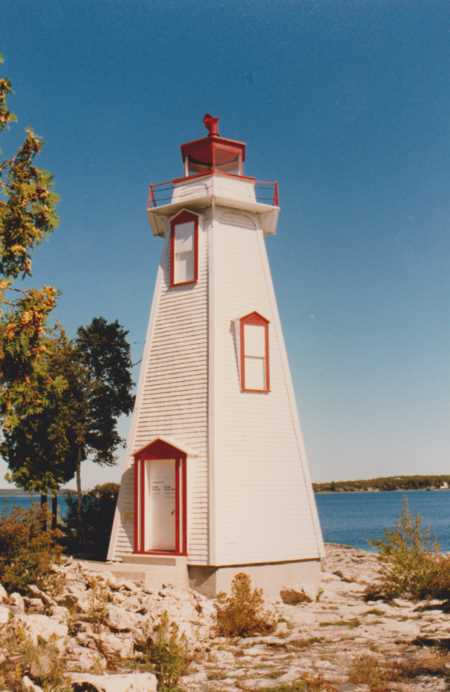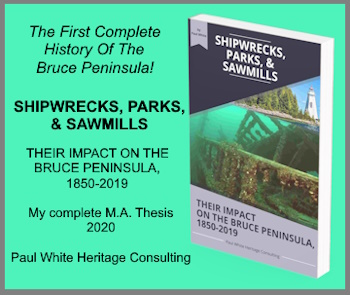Lighthouses Vital
to Georgian Bay Sailing
Lighthouses were vital to Georgian Bay and Great Lakes sailing traffic. They
assisted mariners in making their sailing a safe venture in the often dangerous waters surrounding the Bruce Peninsula.
In the early days of settlement, the arrival of spring was eagerly awaited by the Bruce Peninsula pioneers. The lack of safe and efficient overland routes to the more settled regions of the colony left the area virtually isolated from the rest of the world during the winter months.
By March, the pioneers' larders were close to being empty, and the storerooms of the commercial traders were in a similar state.
Consequently, everyone was awaiting the arrival of the first vessels laden with produce.
The first ships of the season faced difficult conditions. Fierce storms and heavy waters made sailing treacherous. The rugged shoreline made finding a safe haven as treacherous as the swelling waters, winds, and torrential rains, and snow from which they which they were trying to escape. This treacherous weather often took a heavy toll on the early maritime traffic on Georgian Bay and Lake Huron.
As the population of the area increased, so too, did the traffic on the lakes. To help alleviate the dangers to the sailors and their ships, lights were erected along both the Lake Huron and Georgian Bay shorelines.
The first lighthouses on Lake Huron were erected on the American
shoreline. The first, the Fort Gratiot Light, at the entrance to the St. Clair
River went into service in 1825. By 1840, there were four American lighthouses
on Lake Huron. The first Canadian light on that lake went into service in
1847 at Goderich.
The First Georgian Bay Lights
The arrival of rail connections to the Georgian Bay shores in the 1850s, and the opening of the Sault Ste. Marie canal in 1855, increased maritime traffic and signaled the need for lights, especially in the Tobermory area.
In 1859 the Cove Island lighthouse went into service. In 1870, a
light was erected on Lonely Island and in 1897 another was installed on
Flowerpot Island. It was hoped that these beacons would provide a safer path
for mariners through the treacherous waters surrounding the Bruce
Peninsula.
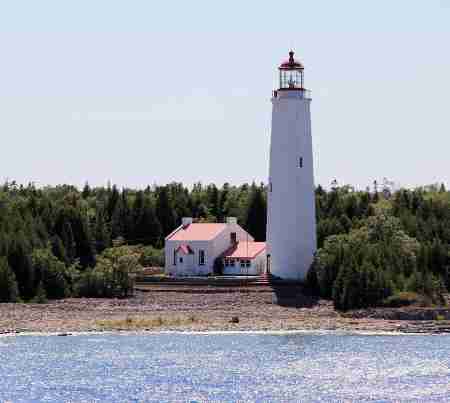 Cove Island Lighthouse and Keepers House
Cove Island Lighthouse and Keepers HouseThe Cove Island lighthouse was one of six completed during the rush to improve and secure safe navigation on Lake Huron and Georgian Bay in the 1850s. The other five were at Point Clarke near Kincardine, Chantry Island at Southampton, Griffith Island at the entrance to Colpoys Bay, Christian Island, and Nottawasaga Island.
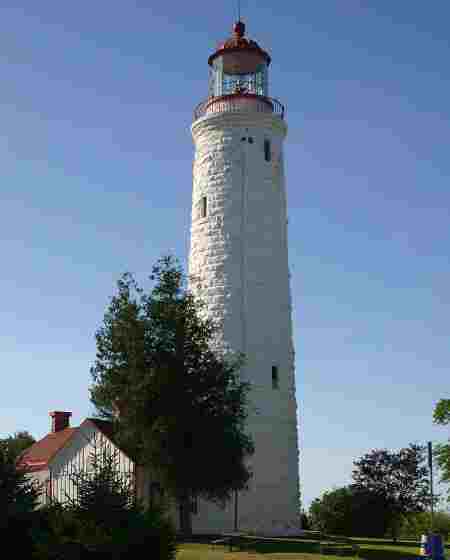 Point Clark Lighthouse at Kincardine
Point Clark Lighthouse at Kincardine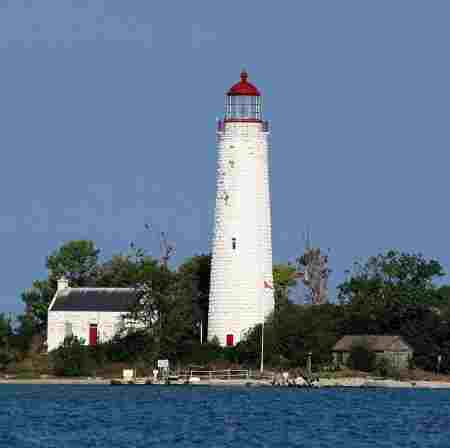 Chantry Island Lighthouse & Keepers House
Chantry Island Lighthouse & Keepers House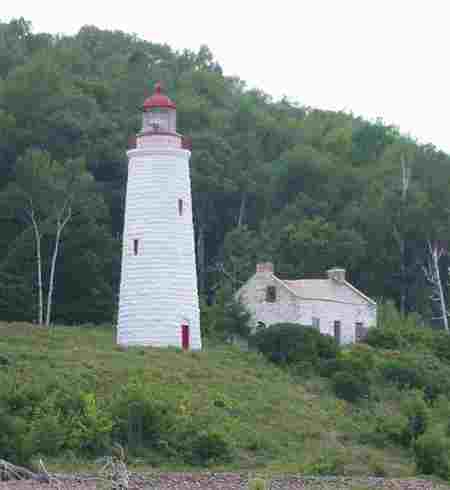 Griffith Island Lighthouse At The Mouth Of Colpoys Bay
Griffith Island Lighthouse At The Mouth Of Colpoys BayLighthouses Built by John Brown
These lighthouses were constructed simultaneously by John Brown, a Thorold area contractor. They were simple structures. But due to their remote locations, not easily built. The decision to build them was not only beneficial to navigation, but also proved to be a boon to area workers and entrepreneurs. Quarries were opened at Owen Sound, Main Station Island, and Inverhuron. The stone for the base and the exterior facing of the structures came from the Owen Sound quarry and the cement was shipped in from Brown's Thorold mill.
In the Owen Sound area, the Presqu'lle lighthouse was an important maritime structure. It was the last light to be extinguished each autumn and the first lit in the spring. Area newspapers announced that it was in operation and this information received front page coverage in both the Wiarton and Owen Sound newspapers!
Although these lighthouses were built to help mariners sail safely through treacherous water, there were still many shipping disasters in the area. But they were more than a device for improving maritime safety.
The news that the
lights were operational was also a much awaited harbinger of spring for
most of the settlers in the Georgian Bay area.
This article originally appeared in my weekly column in the Owen Sound Sun Times.
More Georgian Bay Sailing Stories
Lighthouses were vital to Georgian Bay and Great Lakes sailing traffic. They assisted mariners in making their sailing a safe venture.
Recreational Boating on Georgian Bay There is a long tradition of recreational boating on Georgian Bay. Reports indicate that regattas were being held at Owen Sound as early as 1852.
Great Lakes Recreational Boating Great Lakes recreational boating has been a popular pastime in the summertime in the Georgian Bay region for many years.
Yachts on Georgian Bay A history of yachts on Georgian Bay.
Georgian Bay Ferry Boat Service between Tobermory and Manitoulin Island has a history that is more than a century old. Today, the Chi-Cheemaun continues that tradition.
Ferry boat service after 1930 increased in activity between Tobermory at tip of the Bruce Peninsula and Manitoulin Island
1867 Election Meant Sailing to the Soo. There was only one polling station in the Georgian Bay region in the first election after Canadian Confederation and that was in Sault Ste. Marie!
A Flowerpot Island boat trip takes you to one of the many Georgian Bay islands dot the landscape of the waters around Tobermory at the tip of the Bruce Peninsula. One island features not only unique landforms and vegetation, but also a mysterious indigenous Romeo and Juliet tale of romance.
Chicora the first stage of an 1871 Great Lakes tour aboard a cruise ship on Georgian Bay.
Chicora the final stage of an 1871 cruise a foggy voyage on the Great Lakes.
Historic Vacations: King's Royal Park Historic Vacations: King's Royal Park, opulent adventures for the wealthy of the day. It was the late 19th century and tourism was beginning to bloom.
Sailing the Lake Huron Shoreline is a step back in history and a delightfully scenic trip. But beware of the big waves that can arise anytime!
Sailing Lake Huron Shoreline Part 2 takes us through the most treacherous part of our voyage and also a most interesting part as we visit some unique islands.
Georgian Bay Sailing Georgian Bay Sailing history is a rich tapestry of tales of heroism, tragedy, and exploration. Sailing vessels traversing the rugged waters of Georgian Bay predate the arrival of European explorers and settlers.
Boating for Recreation on Georgian Bay and beyond had an early start once settlement began in the region. As early as the 1850s pleasure crafts were popular.
